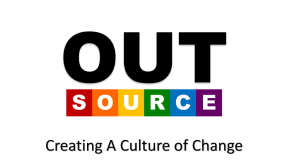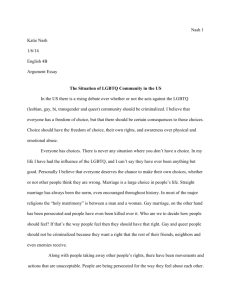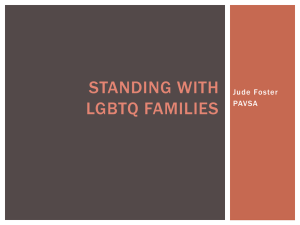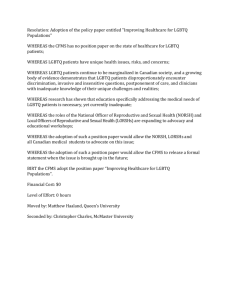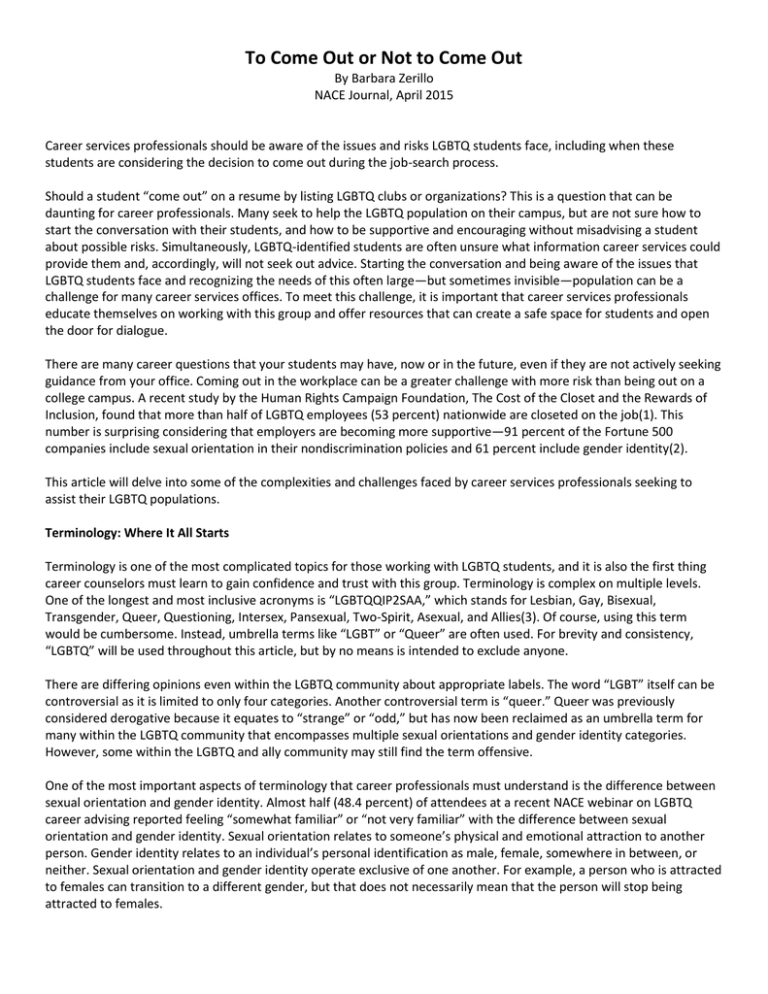
To Come Out or Not to Come Out
By Barbara Zerillo
NACE Journal, April 2015
Career services professionals should be aware of the issues and risks LGBTQ students face, including when these
students are considering the decision to come out during the job-search process.
Should a student “come out” on a resume by listing LGBTQ clubs or organizations? This is a question that can be
daunting for career professionals. Many seek to help the LGBTQ population on their campus, but are not sure how to
start the conversation with their students, and how to be supportive and encouraging without misadvising a student
about possible risks. Simultaneously, LGBTQ-identified students are often unsure what information career services could
provide them and, accordingly, will not seek out advice. Starting the conversation and being aware of the issues that
LGBTQ students face and recognizing the needs of this often large—but sometimes invisible—population can be a
challenge for many career services offices. To meet this challenge, it is important that career services professionals
educate themselves on working with this group and offer resources that can create a safe space for students and open
the door for dialogue.
There are many career questions that your students may have, now or in the future, even if they are not actively seeking
guidance from your office. Coming out in the workplace can be a greater challenge with more risk than being out on a
college campus. A recent study by the Human Rights Campaign Foundation, The Cost of the Closet and the Rewards of
Inclusion, found that more than half of LGBTQ employees (53 percent) nationwide are closeted on the job(1). This
number is surprising considering that employers are becoming more supportive—91 percent of the Fortune 500
companies include sexual orientation in their nondiscrimination policies and 61 percent include gender identity(2).
This article will delve into some of the complexities and challenges faced by career services professionals seeking to
assist their LGBTQ populations.
Terminology: Where It All Starts
Terminology is one of the most complicated topics for those working with LGBTQ students, and it is also the first thing
career counselors must learn to gain confidence and trust with this group. Terminology is complex on multiple levels.
One of the longest and most inclusive acronyms is “LGBTQQIP2SAA,” which stands for Lesbian, Gay, Bisexual,
Transgender, Queer, Questioning, Intersex, Pansexual, Two-Spirit, Asexual, and Allies(3). Of course, using this term
would be cumbersome. Instead, umbrella terms like “LGBT” or “Queer” are often used. For brevity and consistency,
“LGBTQ” will be used throughout this article, but by no means is intended to exclude anyone.
There are differing opinions even within the LGBTQ community about appropriate labels. The word “LGBT” itself can be
controversial as it is limited to only four categories. Another controversial term is “queer.” Queer was previously
considered derogative because it equates to “strange” or “odd,” but has now been reclaimed as an umbrella term for
many within the LGBTQ community that encompasses multiple sexual orientations and gender identity categories.
However, some within the LGBTQ and ally community may still find the term offensive.
One of the most important aspects of terminology that career professionals must understand is the difference between
sexual orientation and gender identity. Almost half (48.4 percent) of attendees at a recent NACE webinar on LGBTQ
career advising reported feeling “somewhat familiar” or “not very familiar” with the difference between sexual
orientation and gender identity. Sexual orientation relates to someone’s physical and emotional attraction to another
person. Gender identity relates to an individual’s personal identification as male, female, somewhere in between, or
neither. Sexual orientation and gender identity operate exclusive of one another. For example, a person who is attracted
to females can transition to a different gender, but that does not necessarily mean that the person will stop being
attracted to females.
The LGBTQ umbrella casts a wide net. Career professionals may find that there are diverse cultures, values, and
preferred language within this community on campus. Every campus is different, so it is important to work with the
students at your school to learn more about their specific needs and concerns. Do not assume that all students will
prefer to be identified by the same term. It is important to allow students to use their preferred language and avoid
assuming that all students from this population will be the same.
Why LGBTQ Students Are Not Coming to Your Office
There are many reasons why a student, even if he or she is out to peers on campus, may not consult the career services
office with LGBTQ-specific questions. Coming out is a process that often involves varying layers. A student may be out to
peers, but not family—or out to family, but not out at a part-time job. There are many factors that have an effect on
students coming out on campus, including their families, athletic community, native country, location of the school,
religion, and workplace or campus culture. A student that comes across as extremely confident about his or her sexuality
on campus may be simultaneously struggling with relationships with family members. Students may not want to admit a
fear of coming out in the workplace or questions they have as it may betray their proud self-image. It is important for
students to know that they can be proud of their orientation or identity and still ask questions or have concerns about
their future career.
It can be difficult to quantify the number of students in the LGBTQ group on campus as many students may be
questioning their gender identity or sexual orientation and may not be ready to label themselves. Others may begin
school with one sexual orientation or gender identity and transition during or after school to another. Additionally, all
students will not necessarily join LGBTQ groups on campus, especially if there is only one or two. As discussed
previously, the diverse language and culture of these groups can make it challenging for a student-run organization to be
inclusive of the vast number of different identities under the LGBTQ umbrella. Inevitably there will always be more
LGBTQ students on campus than can be quantified through student groups or even self-identification. The inability to
accurately count the number of LGBTQ students on a campus is the primary reason why resources must be offered
regardless of turnout at events or the number of students seeking out specific resources.
How to Reach Out to Students
It’s important to show students that you offer resources to this population for several reasons, including illustrating that
the door is open for dialogue with someone in your office and allowing students a way to do this confidentially or
anonymously. Some schools offer anonymous instant messenger chats for this reason. All staff should participate in
some type of LGBTQ training, whether it be attending a session at a conference, participating in a Safe Zone training
program (www.gayalliance.org/safezonet.html), or getting your office certified by Out For Work (www.
outforwork.org/resources/career_center/index.asp). Placing a sign in your office that shows your support for this
population will also help to start a conversation. Combining the education of career professionals and online in-person
student resources will be beneficial to this student population.
Another effective method to reach these students is to partner with student groups to offer presentations on campus. It
is important to connect with other campus allies as well, since this will create a network of knowledgeable people to
share information with if you or they are faced with complicated questions. Using inclusive language in your office will
also help students to feel more included and safe in your space. All methods of creating a public image of your office as
being accepting and supporting will help open the door to communication and increase contact with this minority
population.
Should You Advise Students to “Come Out”?
It is never anyone’s place to tell someone else when or how to come out. This is a personal decision that will occur when
a student is ready and after he or she has considered both the positive and negative outcomes. Although there are huge
benefits to being out, there can also be some negative consequences; processing the decision beforehand and creating a
support system is important for this process.
As discussed previously, there are many layers to coming out. It is up to the student to decide what is best for him- or
herself. The most important thing to ask the student is how he or she identifies. Some students may feel that their
sexual orientation or gender identity is their whole world, while others may feel that it is only one piece of their puzzle.
Some might prefer to maintain their privacy about their sexual orientation or gender identity to reduce the risk of losing
a job opportunity or promotion. Career counselors should be aware of their own positive and negative bias when
advising a student, and should support the student’s decision.
Although career counselors often want to encourage students to be themselves and be proud of who they are, there are
still 29 states where a person can be fired for being gay and 33 where someone can be fired for their gender identity(4).
There is currently no federal protection against workplace discrimination for sexual orientation or gender identity, which
means that there are still workplaces (including colleges) that legally can and do require employees to sign “lifestyle
pledges” (i.e. a promise to the employer that they will not partake in same-sex relationships) or risk being fired.
LGBTQ employees also face other types of discrimination in the workplace. A recent study by the Human Rights
Campaign (HRC) found that one in four LGBTQ employees reports hearing “That’s so gay” while at work(5). Although
career counselors often encourage students to follow their passion and be who they are, it is important to remember
the unfortunate fact that there can still be negative consequences for LGBTQ students entering the work force.
How a student identifies can influence the job-search strategy. The student may decide to target LGBTQ-friendly
companies and locations, lean toward those companies while keeping other options open, or choose an environment
where the student can maintain his or her privacy. There is nothing wrong with any of these decisions, and it is
important to help a student navigate this process. Researching a company is a key step in any student’s application
process. This can be extended to LGBTQ students to include nondiscrimination policies for sexual orientation and gender
identity. Students can also research if companies offer diversity trainings, gender-neutral bathrooms, insurance policies
that include sex reassignment surgery, and company affinity groups. In states without marriage equality laws, students
may be particularly interested to search for employers that offer domestic partner benefits. Many of the top companies
rated by the HRC include such policies and benefits(6). The HRC website is a great resource for students who want to
target LGBTQ-friendly employers. SimplyHired also has a job-search option that allows students to search only LGBTQfriendly companies(7). This is important for all students, but especially for LGBTQ-identified students—one-fifth of
LGBTQ workers report looking for a new job specifically because the environment wasn’t accepting of LGBTQ identities,
and close to one in 10 (9 percent) successfully left a job for the same reasons; they were not comfortable(8).
Resumes, Cover Letters, and Interviews
By including LGBTQ student clubs or organizations on a resume, a student will, at a minimum, identify him- or herself as
an ally of this community. Helping the student identify the importance of working at an LGBTQ-friendly company will
assist with the decision of whether to put this on the resume. Including this will help students to rule out organizations
that are not supportive. If a student is concerned about listing group involvement, he or she could consider listing an
LGBTQ group as a student affinity group or leaving it off the resume completely. As always, resumes should maximize
information relevant to the job for which the student is applying. Cover letters and interviews are the same. The focus
should always be on what is relevant to the job or internship.
If a student is not involved in an LGBTQ student group, but wants to come out in an interview or cover letter, it is
important to ask the student the purpose and relevance to ensure that he or she has fully considered the reasons for
doing so. This is similar to the typical resume or cover letter critique process where counselors remind students to focus
on relevant topics. There are times when talking about overcoming adversity can be beneficial, but it has to be done in a
way that is appropriate. Stating one’s sexual orientation or gender identity in an interview or in a cover letter can be
seen as inappropriate if there is no relevance to the job description. In an interview, the primary focus should be on the
student’s skills and qualifications for the job, not his or her sexual orientation or gender identity.
Career services staff should continue to educate themselves and provide LGBTQ resources to their entire student body
in order to brand themselves as a supportive and welcoming environment. No matter how big or small an LGBTQ
community is on a campus, it is critical that career services take the initiative and reach out to these students to support
them during college and in their future careers.
Endnotes
1. “HRC Study Shows Majority of LGBT Workers Closeted at the Workplace,” HRC Blog, May 7, 2014.
http://www.hrc.org/blog/entry/hrc-study-shows-majority-of-LGBTQ-workers-closeted-onthe-job
2. “HRC Study Shows Majority of LGBT Workers Closeted at the Workplace.”
3. The Genderbread Person, March 2012. http://itspronouncedmetrosexual.com/2012/03/thegenderbreadperson-v2-0/.
4. Maps of State Laws & Policies: Statewide Employment Laws & Policies. http://www.hrc.org/ state_maps.
5. “HRC Study Shows Majority of LGBT Workers Closeted at the Workplace.”
6. Corporate Equality Index 2015: Rating American Workplaces on Lesbian, Gay, Bisexual and Transgender Equality.
Human Rights Campaign Foundation. 2014.
http://hrc-assets.s3- website-us-east-1.amazonaws.com//files/documents/CEI-2015-rev.pdf.
7. Take Pride in Your Work: Find Jobs in GLBT-Friendly Companies. SimplyHired resource page.
http://www.simplyhired.com/a/special-searches/glbt-friendly
8. “HRC Study Shows Majority of LGBT Workers Closeted at the Workplace.”
Barbara Zerillo is director of career services at Fisher College, where she works closely with students as a career counselor
and as a faculty member. Previously, she was assistant director of Clark University’s LEEP Center and managed employer
relations. She has presented nationally at the NACE conference, EACE conference, and the COWC Professional
Development Day, and presented a NACE webinar. She founded the Worcester Young Professional Women’s Group, a
social and networking group for professionals that identify as LGBTQ in central Massachusetts.

